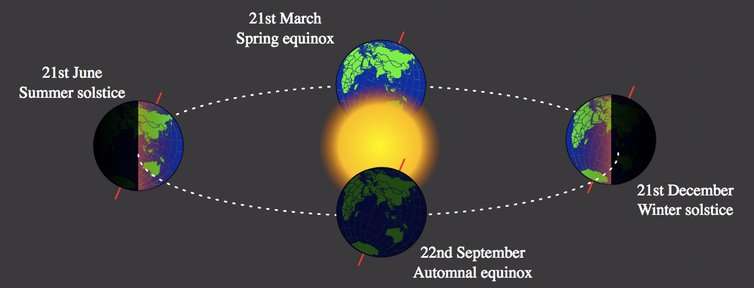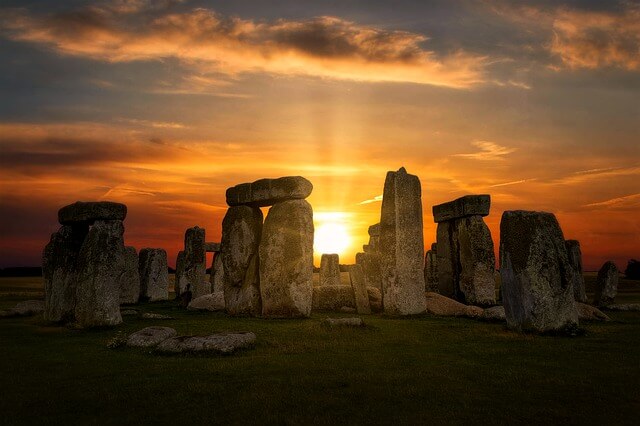What is a solstice? What is the definition of solstice and when do they occur? Is the winter solstice always the first day of winter?
Find out what causes these bi-annual astronomical events, as well as how they generate the shortest and longest days of the year. The shortening of the days and the fall of the temperatures announce the arrival of winter through the northern hemisphere.
This year, the northern winter solstice falls on December 21 at 11:28 a.m. ET. The solstice occurs at the same time throughout the world, although your local time depends on which of the 24 time zones you call home. And to the south of Ecuador, the December solstice marks the beginning of summer.
For people in the north, is the shortest day of the year also the official start of winter? Why does the solstice happen anyway, and how have people observed it throughout the ages? Read on to learn everything you need to know about the December solstice.

WHEN IS THE FIRST DAY OF WINTER?
The reason for the solstice and the seasons is that the Earth is tilted with respect to the sun at an average of 23.5 degrees. This means that the northern and southern hemispheres receive unequal amounts of sunlight for a year as we orbit around our star.
Each hemisphere cools during the part of the year that is tilted away from the sun. The winter solstice (December in the north, June in the south) arrives at the moment when that inclination is at its most extreme angle.
This astronomical event appears in the calendars as the first day of winter, but meteorologists have already had an advantage in the season. By the time the solstice arrives, climate scientists have been watching the winter for almost a month, says Greg Hammer of NOAA’s National Environmental Information Centers.
“The winter weather in the northern hemisphere is always in the months of December, January and February, because they tend to be the coldest months of the year,” he says. “It’s completely based on the annual temperature cycle, instead of astronomy.”
Considering the enormous influence of sunlight on Earth’s climate, why is not the darker part of the year the coldest too?
“Basically, it takes a while for the water and land masses to cool off from all the heat they’ve absorbed” during the summer, says Hammer. “So, the minimum daylight is not followed by colder temperatures until about a month later, it varies from one place to another, but around the third week of January it tends to have the coldest temperatures of the year for most from the USA “
The winter weather reflects more closely our civic calendars and the way most people really think about the seasons, Hammer adds. “We believe that winter is the coldest moment and summer is the warmest, with spring and autumn as a transition”.
And for climate scientists, the following winter weather offers an important simplicity: “It just makes it easier in terms of calculating statistics and making comparisons from one season to the next,” says Hammer. “The solstice moment may vary a bit, so we are comparing apples to apples when we speak seasonally, such as saying that a certain winter was the coldest in a given area.”
SUNSET MORE EARLY? NOT IN THE SOLSTICE
Most of us see the earliest sunset of the year one or two weeks before the solstice. That’s because the sun and our human clocks do not stay exactly at the same time.
We have organized our days into segments of 24 hours, but the Earth does not turn exactly on its axis. While the time from noon to noon is always exactly 24 hours, the time varies between the solar noon, the time each day when the sun reaches its highest point in the sky. As we move through the year, the chronological time of the solar midday changes seasonally, as do the sunrises and sunsets of each day.
During December, solar nodes can occur about 30 seconds after dialing a 24-hour cycle. While the shortest amount of total daylight falls on the solstice, the sunset that day is actually a few minutes later on our watches than at the beginning of the month.
In Washington, DC, for example, the sunset at the solstice will be at 4:49 p.m. ET: four minutes later than December 9.
Closer to the Equator, the earliest sunset of the year occurs in November. To see which matches more closely with the solstice, simply head towards the Arctic. Seasonal changes in the path of the sun through the sky are more extreme near the poles, which makes the hours of sunset at higher latitudes more closely match the solstice schedule.

CAN I SEE THE SOLSTICE?
It is possible to see the effects of the solstice by observing what happens in the heavens above the head, as well as changes in sunlight with time.
For the spectators in the north, the arc of the sun in the sky has been constantly falling and shortening since June. In the winter solstice of the north, it reaches its lowest possible arch, so low that in the few days surrounding the solstice, it seems to rise and settle in the same place. That phenomenon produced the Latin origins of the word “solstice”, which means “the sun stops”.
The low angle of the sun means that your midday shade is the longest it will be throughout the year during the winter solstice.
OLD SOLSTICE SITES
In the ancient world, people built a series of monuments to commemorate the solstice. One example is Newgrange, a huge stone-age burial mound built in the Irish countryside around 3200 BC, roughly a thousand years before Stonehenge. A tunnel facing the solstice sun runs into a main chamber, where the dead may have once been. A small window bathes the camera in solstice light for 17 minutes
The paracas of Peru, who lived around 800 to 100 BC, crossed the desert with lines of land and rock called geoglyphs that connect ceremonial mounds with the place where the winter solstice sun sets on the horizon. The famous Nasca lines, imposing monkeys, lizards and other gigantic figures engraved on the ground by a later Peruvian culture around the year 1 to 700, also present alignments with the winter solstice.
The extensive Karnak Temple of ancient Egypt was built in alignment with the winter solstice in Luxor more than 4,000 years ago. Similar alignments can be seen at Angkor Wat in Cambodia and Machu Picchu in Peru.
CHRISTMAS CONNECTION
For more than two billion Christians, the solstice has been eclipsed for a long time at Christmas. But for the historian David Gwynn of the University of London, the proximity of the two events may not be an accident.
According to Gwynn, one theory holds that Christmas was established on December 25 to replace a Roman feast, which had its roots in the pagan cult of Sol Invictus (“the unbeaten sun”).
Other solstice traditions color the celebrations of today’s winter holidays. The Scandinavians once celebrated Juul, or Yule, a feast of several days marking the return of the sun god. In Great Britain, the druids observed the solstice by cutting the mistletoe.
Some ancient solstice celebrations continue today. The Yalda festival in Iran marks the day when it was believed that Mitra was born, an angel of light. The tradition was adopted in Zoroastrianism and is still observed staying up late and savoring treats like watermelon and pomegranate.
The Dōngzhì festival in China marks the moment when the darkness of winter begins to give way to light. Families watch this time enjoying special foods, such as glutinous rice balls known as tang yuan.